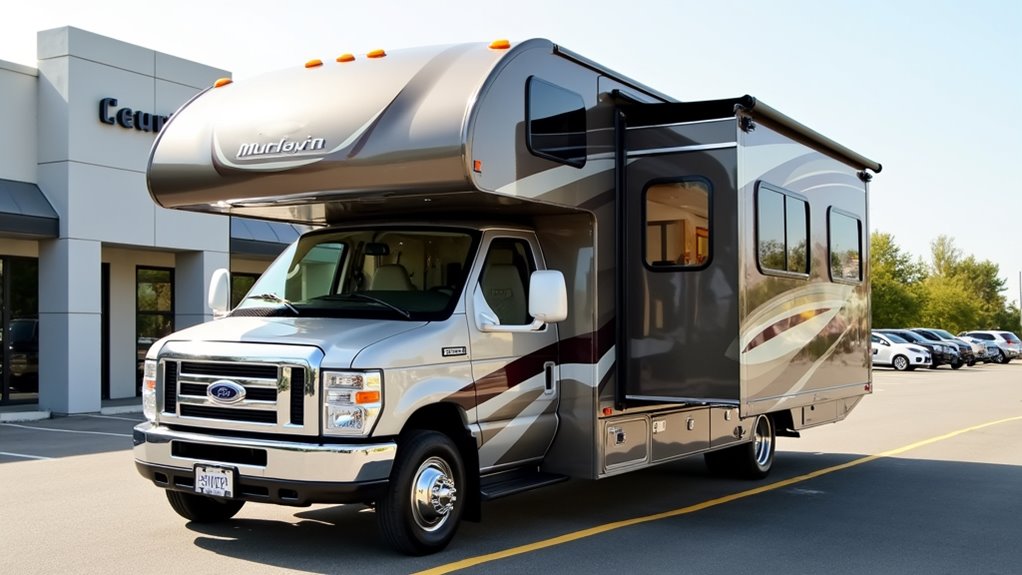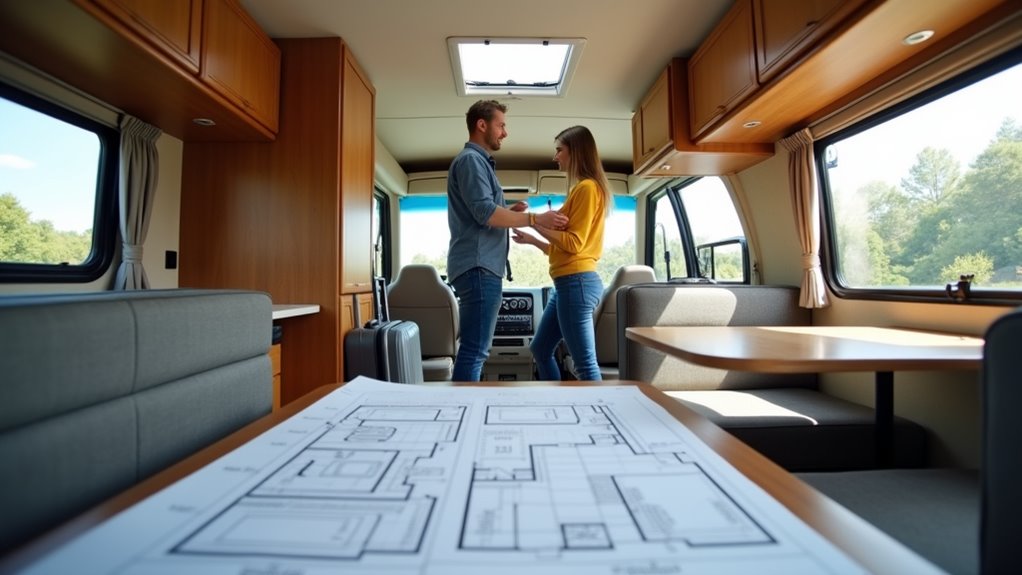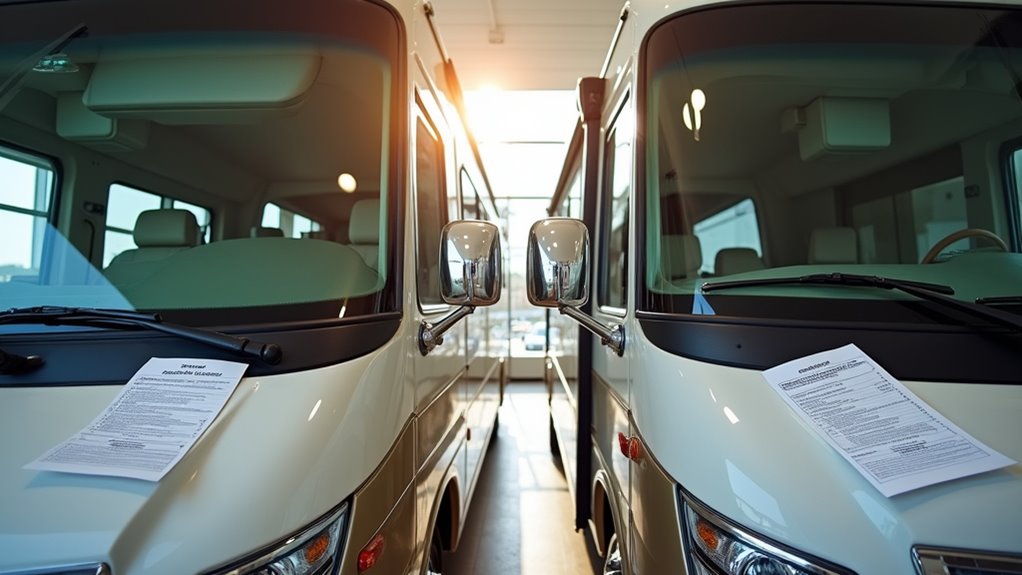Physical Address
304 North Cardinal St.
Dorchester Center, MA 02124
Physical Address
304 North Cardinal St.
Dorchester Center, MA 02124

Anticipating an RV purchase requires careful consideration of budget, size, and travel needs - but there's more you should know.
Whether you’re dreaming of weekend escapes, planning extended road trips, or considering full-time RV living, you will need to navigate numerous vital decisions before making your purchase. You will desire to balance your travel aspirations with practical considerations like budget constraints, maintenance requirements, and space needs. Making the right choice involves understanding various RV classes, evaluating both new and used options, and appraising long-term costs. Let’s explore these essential factors to help you make an informed investment.

Why do you wish to buy an RV? Before making this significant investment, you must clarify your travel goals and lifestyle expectations.
Start by determining if you’re planning weekend getaways, seasonal trips, or full-time living on the road. Consider whether you prefer structured itineraries or spontaneous exploration.
Your RV journey begins with a simple question: Will you chase weekend adventures, follow the seasons, or embrace permanent road life?
Your travel style will directly impact the type of RV you should buy. Following the “330 Rule” for travel can help you determine if you’re comfortable with longer trips and daily driving limits. RV camping tips can provide additional guidance on making the most of your RV experience. Evaluate your comfort with minimalist living, as you’ll have to downsize belongings and adapt to limited space.
Think about who’ll be traveling with you – family members, pets, or solo adventures – and verify your RV choice accommodates everyone’s needs.
Don’t forget to factor in practical aspects like remote work requirements, educational needs for children, and social connections you’ll want to maintain while traveling.
The world of RVs encompasses several distinct classes and types, each designed to meet specific travel needs and preferences.
Only motorhomes are designated with official class ratings in the RV industry. Towable RVs such as travel trailers and fifth wheels do not have official class ratings.
Class A motorhomes offer luxury and spacious interiors but consume more fuel, while Class B campervans provide better efficiency and easier maneuverability.
Class C models strike a balance with their cab-over design and varied floor plans.
If you’re considering a towable option, travel trailers and fifth wheels each have unique advantages. Travel trailers are easier to set up and maintain, while fifth wheels provide more living space with their raised front section.
When choosing your RV, consider key factors like your budget, group size, and intended use. Remember that larger RVs offer more amenities but require more skill to drive and maintain, while compact options give you greater flexibility for campsite access and urban navigation.

Once you’ve identified your ideal RV type, creating a solid financial foundation becomes your next priority.
Before making this notable investment, you’ll need to thoroughly assess your current financial situation and establish a detailed budget that accounts for both immediate and long-term costs.
Your financial planning should include:
Consider exploring and joining RV club memberships to access valuable discounts and resources that can help reduce your overall costs.
Don’t forget to explore various financing options and compare interest rates from multiple lenders.
Your credit score will greatly impact loan terms, so work on improving it if necessary.
Remember to factor in depreciation and avoid stretching your budget too thin – a realistic financial plan guarantees you’ll enjoy your RV adventures without financial stress. Refer to the Essential RV Camping Tips for additional guidance on managing your RV expenses.
Conducting a thorough pre-purchase inspection can save you thousands in unexpected repairs and maintenance costs.
Start with exterior checks, examining the body for dents, seals for leaks, and tires for wear. Don’t forget to inspect the roof membrane and undercarriage for damage.
Move on to mechanical elements, checking all fluids including engine oil, coolant, transmission, and brake fluid. Test the batteries for proper function. Having an inspection checklist ready helps ensure you don’t miss any critical components during the review. Dry RV camping requires careful inspection of the RV’s systems and components.
Inside, inspect flooring for water damage, test cabinet functionality, and verify all appliances work correctly.
Pay special attention to electrical systems by testing lights, outlets, and safety features.
Finally, check slideouts for alignment, plumbing for leaks, and guarantee HVAC systems function properly.
If you’re not confident in your inspection abilities, hire a professional RV inspector – it’s worth the investment.

When selecting an RV floor plan, your travel party’s size and lifestyle needs should drive the decision-making process. You should assess how your group uses space and prioritize features that match your daily activities, whether that’s cooking, entertaining, or outdoor adventures.
Consider these critical layout factors:
Remember to analyze storage capacity carefully. You’ll need adequate space for everyone’s belongings, outdoor gear, and essential supplies while maintaining comfortable living quarters. For families traveling with children, a bunkhouse floor plan offers dedicated sleeping arrangements without compromising living space. Plus, RV Camping outshines tent adventures by providing more amenities and protection from the elements.
Beyond choosing the right floor plan, understanding the mechanical and technical specifications of an RV will help you make a smart investment and guarantee safe, reliable travel.
Focus first on weight ratings – verify the GVWR matches your towing vehicle’s capacity and check the cargo carrying capacity to confirm you can pack what you need. The proper tongue weight distribution helps maintain stability while towing. Choosing the right caravan tow vehicle is crucial for a successful caravan adventure. Don’t overlook essential systems like generator output and electrical capacity, which determine your comfort on the road.
Weight ratings and power systems aren’t glamorous details, but they make the difference between stress-free travels and roadside headaches.
Pay special attention to construction quality, including chassis specifications and insulation. You’ll want adequate freshwater capacity and properly sized waste tanks for your travel style.
Finally, inspect safety features like brake systems, tire ratings, and fire equipment. These technical details might seem overwhelming, but they’re vital for selecting an RV that’ll serve you well and maintain its value.

Should you choose a new or used RV? Your decision will greatly impact your investment and overall ownership experience.
New RVs offer cutting-edge features and extensive warranties but come with steeper price tags and faster depreciation, losing about 20% in the first year.
Consider these key factors when making your choice:
After deciding between new and used options, understanding RV safety features becomes your next major priority.
You’ll need to verify that all lights, signals, and brake systems are fully operational. Check that safety chains are properly installed and tires maintain correct pressure levels. All trailers weighing over 3,000 pounds must have trailer brakes, a breakaway switch, and safety chains.
For exterior safety, ascertain reflective markings meet state requirements and weight is properly distributed. Proper weight distribution is crucial for maintaining control and stability while driving.
Don’t overlook interior features – smoke detectors, fire extinguishers, and securely anchored furniture are essential. If you’re towing, confirm your vehicle can handle the trailer’s weight and that the hitch system is compatible.
Remember to research your state’s specific regulations regarding RV size and safety standards.
While RVs don’t undergo crash testing like cars, they must comply with federal guidelines. Regular inspections will help maintain these safety features throughout ownership.

When purchasing an RV, you’ll need to understand your insurance obligations and legal requirements upfront to avoid costly surprises. Most states require liability insurance for motorized RVs, while extensive and collision coverage is typically mandatory if you’re financing. Your premiums will depend on factors like RV type, usage, and storage location. Driving history records will significantly impact your insurance rates.
RV insurance requirements vary by state and financing terms, with premiums based on vehicle type, use patterns, and storage choices.
Consider these essential coverage and compliance elements:
Remember to notify your insurer about any modifications or changes in RV use, as these can affect your coverage and rates.
Keep documentation of all insurance, warranty, and registration requirements readily accessible.
Long-term maintenance planning serves as the backbone of RV ownership, protecting both your investment and safety on the road.
You’ll need to establish a thorough maintenance schedule that includes monthly system checks, quarterly oil changes, and semi-annual inspections of wheel bearings and suspension components. Your maintenance routine should include sanitizing freshwater tanks annually to ensure safe drinking water. Maximizing your RV adventures can also be achieved through proper maintenance planning.
Create a realistic budget that accounts for routine maintenance, potential repairs, and future upgrades.
You should factor in both DIY tasks and professional services – while you can handle basic maintenance yourself, complex repairs often require expert attention.
Consider investing in essential tools and maintenance guides specific to your RV model.
Track your maintenance activities using mobile apps or digital calendars, and build relationships with local repair shops.
Don’t forget to adjust your maintenance schedule based on seasonal use and storage requirements.
Your RV journey’s like steering a winding road – you’ll need careful planning and clear direction. Don’t let your dreams of freedom hit roadblocks by overlooking vital details. Whether you’re choosing a compact trailer or a luxurious Class A, your wallet and lifestyle should steer your decision. Remember, just as a compass guides travelers, thorough research and inspection will point you toward the perfect RV match, ensuring years of memorable adventures ahead.